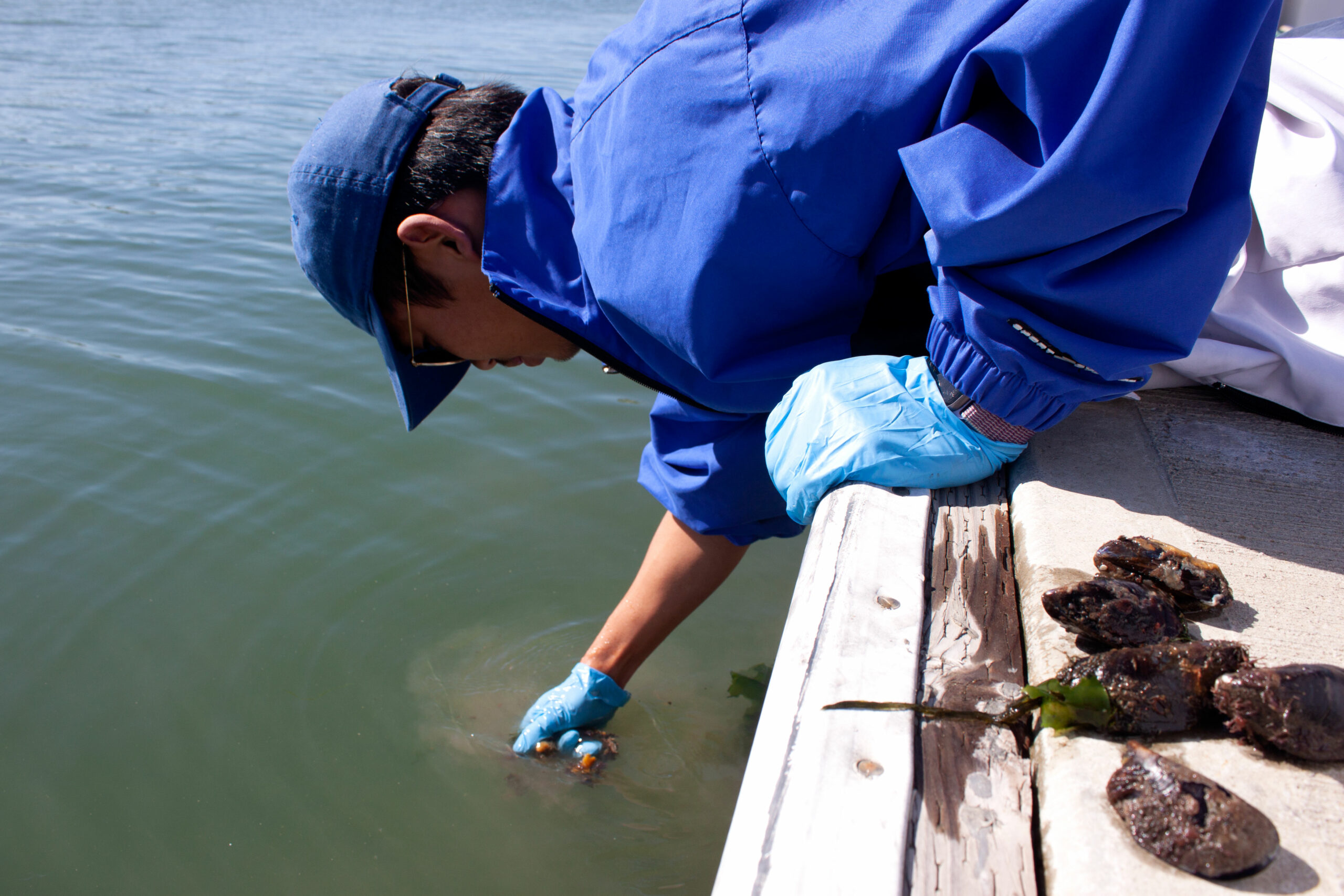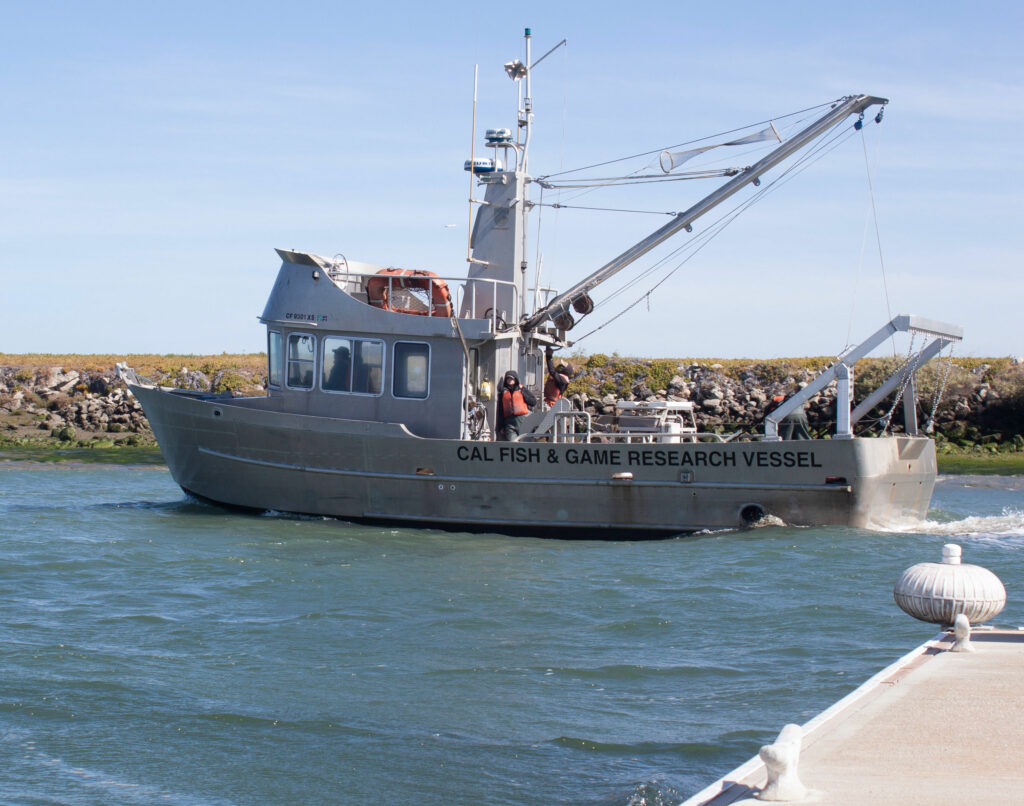
Martin Trinh practically bounces along the dock at the Coyote Point Yacht Club on a breezy, sunny spring morning. He’s carrying a case full of instruments and scopes out an open slip at the end of the pier. Soon he’s lowering a probe into the water, alongside kelp clinging to the underside of the dock. Another trip back to his Prius, still sporting South Carolina license plates, and he’s got a white plastic dish pan and a scrub brush. He fills and rinses a brown plastic bottle several times before finally capping it while full and placing it into a zip-top plastic bag. Then he lies on his belly, reaches into the water, and with blue nitrile gloves feels amidst the kelp for the last thing he needs here today: five medium-size mussels.
“While I’m looking for the mussels, I’m also looking to see how many mussels are there, what is the average size of a mussel?” he says. “It looks like this site is a little sparse.” He gets his catch and then scrubs them clean before bagging them to take to the lab.
Trinh began his work as an environmental analyst with the San Francisco Estuary Institute (SFEI) less than a year ago, shortly after graduating from Duke University in Durham, North Carolina. “I’ve been primarily continuing the projects and the passions I’ve had from my undergraduate studies,” he says, “analyzing what we call ‘contaminants of emerging concern.’”
In college, Trinh combined his love of science and the outdoors. “I realized this confluence between the environment and human health was something that I was really interested in,” he said. “It was a lot more fun getting out in the field” versus being in an indoor lab.
His persistent smile shows he’s enjoying the work. He’ll deliver these and other samples to the SFEI lab in Richmond, where the water will be tested for chlorophyll and phytoplankton and the mussel tissue will be analyzed for domoic acid, microcystin, and saxitoxin. SFEI is the lead institution implementing the San Francisco Bay Nutrient Management Strategy. Sampling throughout the Bay happens every other week. Together these data will give an indicator of the presence of harmful algal blooms, Trinh says.
San Francisco Bay gets a lot of nitrogen and phosphorus washed into its waters. This human-caused nutrient loading, which occurs at higher levels in San Francisco Bay than in some other estuaries in the country, can cause harmful algal blooms that threaten both recreational uses and drinking water. As SFEI outlines on its website, “[until recently], the Bay was considered to have innate strong resistance to high nutrients. However, recent observations suggest that the Bay is experiencing a ‘regime shift’ toward higher sensitivity to nutrients.” Monitoring nutrients through regular sampling will help scientists establish and maintain a consistent picture of what’s happening.
Trinh’s work as an undergraduate introduced him to the long-lasting impacts that water pollution can have on surrounding communities. His focus was on PFAS (per- and polyfluoroalkyl substances), which are often called “forever chemicals” because they don’t break down in the environment. They’re found in certain coated paper packaging, non-stick cookware, and water- and stain-resistant fabrics, have been implicated in a variety of human diseases, and often get washed into waterways. Studying these at Duke led Trinh to the fields of environmental toxicology and environmental justice. Born and raised in Spartanburg, South Carolina, he says he came to realize that “these adverse health effects impact different people differently.”
Trinh’s supervisor, Melissa Foley, who runs SFEI’s Regional Monitoring Program, says that combination helped Trinh land his current job. The Regional Monitoring Program, or RMP, collects data that informs management decisions about contaminants in the Bay. Foley says SFEI’s goals include environmental justice. “He also has done a lot of work in his spare time volunteering for different immigrant groups in the Carolinas,” Foley says. “That’s an area where SFEI is really looking to expand our work.”
Trinh has attended community meetings to hear from people with varying interests in the Bay’s health and to take notes and provides summaries to colleagues. He says he also talks to locals when he’s on a dock or shore gathering samples to bring back to the lab. Hearing from these people about their different connections to the Bay is something he enjoys.
“It’s pretty awesome,” he says. “People are always curious to hear what we’re doing. [So I have] a wealth of conversations with different community members, which are very informative for us and for them. It’s a symbiotic relationship.”
Foley says these conversations are fundamental to SFEI’s efforts to engage everyday people. “The community provides, oftentimes, a different perspective than the management agencies do.”
Trinh sees, and is able to share with others, how what happens in the Bay will impact various groups of people differently. “Investigating how different areas of the Bay … affect different populations, and their specific cultures, has been a real focus of SFEI in the past couple years,” he says, which added to his interest in the organization. North Carolina, he notes, “has a rich history of environmental activism and then environmental tragedy, as well,” like drinking-water wells contaminated with PFAS. He’s pleased to see that California has been more proactive, for example by banning long-chain PFAS before the federal government.
At stop number two on this day, South San Francisco’s Oyster Point Marina, the wind is strong and Trinh pulls out his smartphone to check the speed. It’s about 12 mph and he mentions that when he’s playing beach volleyball, a 10 mph wind is “definitely a factor.” He declines to play if it exceeds 15 mph. But he’s enjoying his sport here and the shared place he’s renting in San Francisco. Moving during the pandemic opened options he says he might not otherwise have had; plus, being young, nimble, and gregarious, he didn’t balk at housemates.
A sudden gust grabs a plastic baggie Trinh had tried to secure. It lands in the water nearby and he gets back down on the dock, pulls up his windbreaker sleeve and waits as the soggy bag floats to within reach. He snatches it, then looks around carefully for something heavy enough to hold it in place until he fills it.
For the Regional Monitoring Program, Trinh says his field work is often reactive in the sense that just after a heavy rain, he and colleagues will grab pre-staged equipment they keep at the ready and rush out. That’s because his main assignment is as part of the stormwater monitoring team. During and right after a storm, runoff washes contaminants directly into the Bay. That’s when his team wants to capture and analyze samples. But in California’s persistent drought conditions, opportunities to leap into action are few and far between. “There was this time period in October, November, where we were going out a decent amount,” he says, “and we thought, ‘Oh, this is forecasting a really good year, a really wet year.’ And since then, nothing.”

That makes him available to fill in with the harmful algal bloom project on this day, or with water-sampling cruises on others. From the pier at Coyote Point, he watches as a California Fish and Wildlife research vessel goes by. It’s the type of boat he’ll board for field work that can’t be done from terra firma. He has one more stop this Thursday, at the Golden Gate Yacht Club in San Francisco, before heading across the Bay in his trusty Prius to deliver all of his carefully labeled samples to the lab.
Foley says Trinh is just as eager to help “pull together all the necessary details to keep a program running” on the back end. He handles contracts with labs and other partners and keeps track of what the internal staff needs. “There’s a lot of moving parts to the program,” she says, and Trinh has been a “super go-getter,” jumping in wherever he’s needed. “Usually, it takes a little bit longer for us to give [new staff] technical projects,” such as literature reviews, data analysis, and visualizations or writing reports, she says. About two months shy of his one-year anniversary, “he’s really one of the co-leads for coordinating and doing our stormwater monitoring.”
The environmental analyst role at SFEI, Foley says, is often a young scientist’s introduction to professional research in a nonprofit setting. “They’re a really important component in our staff,” she says, but the institute also wants to make sure the “EAs” have a fruitful experience. “We’re hoping that we’re kind of helping to create a pipeline of folks,” she says, who “can take that experience and incorporate it into their future.”
Trinh appears poised to do just that.
Top Photo: Martin Trinh. Photo: Amy Mayer
Related Estuary Stories